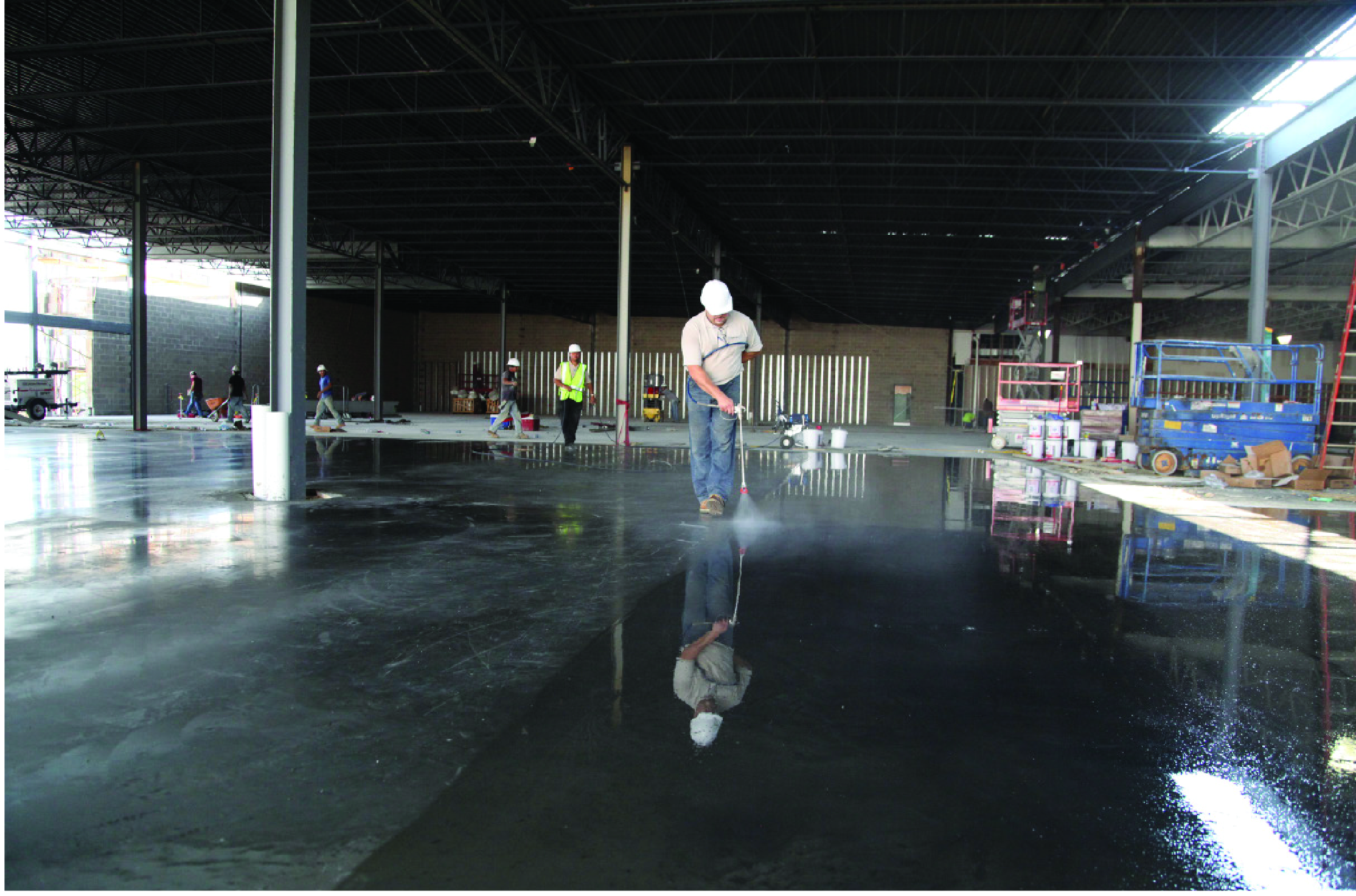Proper Curing Time For Concrete Slabs
What is Concrete Curing?
Concrete curing methods refer to techniques used to maintain the amount of moisture in the concrete to help it retain its properties. As a process, curing influences the strength, durability, abrasion, volume stability, resistance deicing salts and freeze/ thaw cycles. If curing is inadequate, these properties could be reduced significantly.

Why Curing Is Necessary
As soon as cement and water are mixed, a chemical reaction referred to as hydration starts taking place. The hydration process increases the density and durability of the concrete. The more the hydration, the higher the properties. Complete hydration of cement takes place after a very long period of time. Even when the surface becomes hard, the hydration process will continue taking place as part of concrete curing process.
If the mixture received enough water, 30% of the process will be completed within the first 3 days. 60 percent will have taken place within 7 days and 98 % will be completed within 28 days. Freshly mixed cement will have more water than what is required in hydrating the mixture. In the first 2-3 days, water is lost due to bleed and evaporation. It reduces water content in the mixture and eventually stops or slows the hydration process. Therefore, it is critical that water evaporation be minimized during concrete curing time for long term durability. Excessive loss of water causes shrinking and creates tensile stress in the concrete.
If the stress becomes severe before the concrete acquires enough tensile strength, it makes the surface to crack.

Fast Curing Concrete Process
Water is held in the concrete in two ways:
- Wet curing – where concrete is kept wet for a period of seven days. This could be done by ponding, fogging, spraying, immersion and applying saturated wet coverings like burlap.
- The surface of the concrete should be sealed so that water is prevented from evaporating. This method entails covering the concrete with plastic sheets or impervious paper, or simply applying curing compounds so that they form a membrane on top of the surface. A penetrating concrete sealer works as well.
Each of these methods has disadvantages and advantages. But combining the two could give better results. However, it is always dependent on size, location, shape, economics or environment.
Wet curing- where the surface is flooded with water. It is the most ideal method for concrete curing. Wet curing should last for 7 days for better results. Never allow the concrete to dry in between stockings. Alternating drying and wetting of the surface will only damage the concrete. Membrane curing is therefore preferred as a method of curing concrete.
Membrane curing method is commonly used to cure concrete. Compounds such as waxes, chlorinated rubbers, resins, epoxies and styrene acrylics are good curing compounds. Using such compounds come with a number of advantages including ease of applications, cost effectiveness, and allow for an extended curing action beyond the 7 days, as it is in the wet curing process.
Types of Concrete Curing Membrane Available
Membrane that forms curing compounds are of two types: clear curing compounds that contain fugitive dye which makes it easy to check for a complete covering of the concrete surface when certain compounds are applied. Ideally, the dye will fade away after a number of days. The white pigmented curing compounds come with added benefits such as light reflectivity which help to keep the concrete cool and improve the hydration process.
How do water-based curing products compare with solvent based?
Any curing compound that passes ASTM C-309 is effective in retaining moisture. However, the individual situation should dictate the type of cure that should be used. Even though, they are suitably used for interior applications. Water based materials have a lower odor and low Volatile Organic Compounds (V.O.C’s). Water-based products are suitable in interior occupied areas. Note that water based cures should not be used in areas where the temperatures are expected to go below 50˚F before drying because they will not form a film if the concrete curing temperature is low. Note that all water based products will appear white when they are applied for the first time.
The white pigment such as titanium dioxide stops water based curing compounds from drying. It requires water and soap to clean them while the solvent based ones require mineral spirits to clean them up. Mixing water-based and solvent based cures should be avoided. If the two are to be used, one must have different spray equipment to reduce the need for extensive clean out when switching from one equipment to the next.
When and How To Apply Curing Compounds
In case of fast curing concrete, clearing compounds must be applied immediately after the final finish. It should be done after the sheen has disappeared from the concrete. ASTM C-309 and ASTMC-1315 require that curing compounds be applied at a rate of 200 to 300 sq. ft per gallon. Using hand held power driven spray equipment with a fan tip is recommended. However, one may opt to use brushes and rollers. It does not matter how you choose to apply the cure. A uniform and continuous film without pinhole and gaps could be used to maximize on moisture retention.

Can proper curing make the concrete durable and reduce chances of crack and spall?
This is not true since there are many factors that affect the strength and the durability of the concrete.
Air entrancement of the exterior concrete is an important element that determines the durability of the concrete during the freeze/thaw cycles. Little air entrainment, contraction of the concrete during freeze thaw will make the surface to spall and cause cracking. Too much air interferes with concrete curing process, reduces concrete strength and makes it porous.
Overwatering, overworking, and poor finishing techniques will weaken it, make it crack and spall. The quality of ingredient and the mix design of the concrete are essential. Stones that are porous can easily explode during the freeze/thaw conditions. When concrete contains too little cement, too much water, too much fly ash, improper combination of concrete add-mixtures will not perform to the expectations of the customer in the long run.
Aggressive chemical attack by deicing salts and other chemicals in the first years of the concretes life can completely damage the surface. If the concrete is cured as it should, it reduces surface dusting, reduces cracks, leads to carbonation, and will eliminate the need for good concrete practices.
Do some curing materials do a better job than others?
Yes, some materials retain more water than others. Generally, the thickness in the film determines the effectiveness of vapor barrier. Solids that form thicker films have more moisture than those that do not. Normally, the minimum solid level required to pass ASTMC -309 is 15 %. Other common solid levels required to cure compounds are those that are 30%, 25%, 20% solid.
Spray-Lock SCP 327
SCP 327 is able to penetrate and provide permanent concrete waterproofing and protection – and it does this as a one-time spray on treatment. It can be effectively applied on either side of concrete structures – both positive and/or negative and can withstand over 250 feet of hydrostatic pressure. As another benefit there is minimal disruption of the site which allows other trades to gain access to the site in a timely manner.
The difference between curing & sealing and using a curing compound
All curing products are designed to go over fresh concrete. They do this by dissipating quickly in 30 days. Normally, the hydration process of cement will be completed by the time the curing compound wears off. Curing & sealing materials may be applied to cure fresh concrete but can also be applied to older concrete. The underlying reason is that it can keep water and salts and other materials out of concrete to reduce the rate at which it retains water. Cure & seal products are solids that contain concrete curing agents and raw materials that enhance durability.
If they are applied on fresh materials, the products will last for more than a year. A second coat of cure should be applied a few months after the concrete has been cured to help thicken the membrane. It gives an added sealing protection for the concrete. Some curing and sealing products can be expensive as they are designed and meant for curing only.
The time it takes to cure the concrete surface
Curing compounds are designed to last for 28 days. Various curing and sealing products remain on the surface for a longer period of time. When the concrete is treated with another product such as an epoxy or penetrating sealer, the curing compound should be removed before any of the products is applied. There are a number of products described as dissipating resins. They are designed to breakdown on their own after 28 days. Their degree of disintegration is dependent on the amount of ultraviolet light and abrasion.
Compounds to choose from
Ensure that the curing compound you choose is manufactured by a respected company. It should pass the C-1315 or ASTM C-309 test. The specification sets the maximum amount of moisture that should be transmitted via curing compounds. If you are not sure, it is recommended that you ask the concrete contractors to avail a written certification that his compound passes ASTMC-1315 or ASTMC-309. Also, you need to consider the application environment to help you determine whether the water based material is more suitable than the solvent.
The appearance is critical and so you should choose clear and non-yellowing compounds such as pure acrylic. Materials such as linseed oil, styrene and chlorinated rubber are cost effective but will discolor when you continue to expose them to ultraviolet light. This is a critical consideration if you want to buy cure & seal products that will serve you for a longer period. If you choose to place sidewalks, parking decks, mass concrete or a curbing, white pigmented curing to use will always be specified. Selecting a compound that stays in suspension for a little bit longer and which will not necessitate the use of sprayers is recommended. Ensure that you use tested and pre-approved materials D.O.T.
